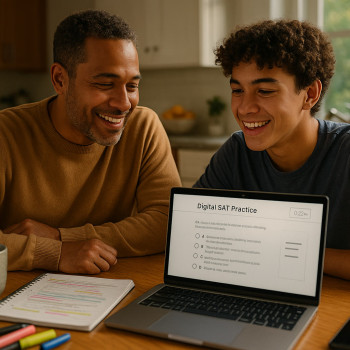Why this checklist matters: a calm roadmap for busy families
If your family is part of the NRI (Non-Resident Indian) or OCI (Overseas Citizen of India) community and you’re preparing for the Digital SAT, first—you are not alone. The Digital SAT introduces device-based testing, tighter security, and slightly different logistics than the paper test many of us remember. For parents balancing move schedules, school calendars across countries, and a thousand little forms, a clear checklist tailored to NRI/OCI students turns overwhelm into action. This post walks you through the essentials, step by step, with practical tips and examples so you can support your student confidently.

Start early: timelines, registration windows, and why dates are everything
For many NRI/OCI families the challenge isn’t just preparing for the test content—it’s aligning test dates with travel plans, local test center availability, and college application timelines. Digital SAT dates are announced by the test provider and seats at international centers can fill up quickly, so treat registration like booking a flight: check early, reserve early.
Practical timeline:
- Junior year spring: ideal time for the first SAT attempt (gives room for retakes in fall of senior year).
- 6–12 weeks before a target college application deadline: confirm your final test date so scores can be sent.
- If planning to test abroad or during travel, search test center availability 3–4 months ahead.
Action items
- Create a College Board account (the student must register themselves for weekend tests).
- Sign up for BigFuture and add target colleges so you understand score deadlines and reporting options.
- Check international test center dates for your country of residence and alternative nearby centers.
Registration essentials for NRI/OCI students
Registering from outside the U.S. follows the same online flow, but with a few extra things to watch for: country selection, acceptable identification, and photo upload rules. The student should handle most of the registration personally, but parents can prepare documents and supervise the final submission.
Documents and details you’ll need
- Valid ID as required by the test center (some centers accept national passports; others have local rules). Confirm the accepted ID for the specific international center before registration.
- Recent passport-style photo that meets the testing authority’s guidelines — check size, background, and format.
- Accurate personal details: legal name, birthdate, and mailing address. These cannot be changed casually after registration, so double-check spelling and format.
- Payment method for the registration fee (and any regional fees). Keep a screenshot or confirmation email after payment.
Tip: Home vs. weekend testing
If the student will test at school on a school-day administration, the school coordinates registration. For weekend testing at public centers, the student must have a College Board account and register personally. Parents should confirm which route applies and prepare accordingly.
Device and app readiness: what the Digital SAT requires
The Digital SAT runs inside a secure testing app (often referred to by its official name). Students must use a compatible device and complete an exam setup before test day. There’s an exam app for the test environment and a separate toolkit for proctors.
Checklist for devices
- Confirm device compatibility well before the test — not every laptop or tablet is eligible.
- Download the official testing app and install updates. Complete the exam setup procedure to avoid last-minute surprises.
- Ensure the device’s battery is healthy; bring a charger and a fully charged backup device if permitted by the center (rules vary).
- Practice typing and using the in-app tools (calculator, highlighting, equation editor if applicable) so the student is comfortable.

Test day logistics for international centers
Test day is simpler when parents have thought through travel time, documentation, and local rules. International centers may have different check-in patterns and security protocols than U.S. sites, so plan with some margin.
What to bring
- Admission ticket printed or ready on a device, with details of test center and reporting instructions.
- Approved photo ID (passport is the most universally accepted ID for international students). Confirm the exact ID requirements for your chosen center.
- Device (fully charged) with the testing app already installed and tested.
- Any permitted items clearly allowed by the test provider (some centers allow certain types of batteries or earbuds; check rules first).
What NOT to bring
- Prohibited electronics or smartwatches.
- Notes or study sheets—these are strictly forbidden in the testing area.
- Food restrictions vary; bring a small snack for breaks only if the center permits it and it’s allowed outside the test room.
Accommodations and special considerations
If your child needs testing accommodations for medical, learning, or other documented reasons, start the process early. Approval often requires submitting documentation and can take several weeks. For families moving between countries, check whether prior approvals carry over.
Steps to secure accommodations
- Gather clinical or school documentation describing the accommodation need.
- Submit the accommodation request through the official services for students with disabilities portal. Begin this process at least two months before your planned test date—earlier if possible.
- If approved, register for the test and confirm that approved accommodations appear on the admission ticket.
- If approval is pending close to your test date, discuss backup plans: register as a standard test-taker for a later date or be prepared to contact services for assistance.
Score reporting, superscoring, and college deadlines
Colleges set their own score policies. Many schools superscore (combine the best section scores from multiple test dates), but policies vary. NRI/OCI students should build a target-school list early and note each school’s SAT policy and application deadline so there’s time to send or withhold scores accordingly.
Practical table: timing and score actions
| When to test | Action | Why it matters |
|---|---|---|
| Junior spring | Baseline test, identify weak areas | Allows targeted prep before senior-year applications |
| Senior fall | Final attempt for application scores | Scores release in time for most Early Decision/Early Action deadlines |
| Last-minute retake | Confirm score reporting dates and send if needed | Allows you to capitalize on an improved score before deadlines |
Financial considerations and fee waivers
Test fees and the availability of fee waivers differ by country. In many cases, fee waivers are restricted to specific groups and regions. If cost is a concern, investigate whether your student qualifies for any fee assistance and consider applying early.
Money-saving tips
- Bundle testing plans with winter/summer prep so travel and registration costs are optimized.
- Use free, official digital practice resources to reduce the need for costly prep packages.
- Consider a targeted tutoring plan (like 1-on-1 sessions) focused on weaknesses rather than blanket hours—more efficient and often more effective.
Study strategy for NRI/OCI students (and how parents can help)
Effective SAT prep isn’t about endless hours of study; it’s about targeted practice and smart review. As a parent you can make a huge difference simply by helping structure time, reducing stress, and encouraging consistent tools.
Sample 12-week study plan highlights
- Weeks 1–2: Diagnostic test and goal-setting. Identify high-value weaknesses.
- Weeks 3–6: Focused practice on core areas (reading passage strategies, grammar rules, math problem types). Use official practice tests weekly to build endurance.
- Weeks 7–10: Timed sections and strategy refinement—work on pacing, calculator familiarity, and digital test tools.
- Weeks 11–12: Final review and light practice; focus on sleep, healthy nutrition, and logistics for test day.
How parents support without doing the work
- Plan practice times and quiet spaces.
- Encourage realistic goals and celebrate incremental wins.
- Arrange mock test mornings so the student practices the exact routine they’ll use on test day.
When personalized tutoring helps—and what to look for
Many families find that strategic, personalized tutoring accelerates progress far more than solo study. Look for tutors who offer:
- 1-on-1 guidance tailored to the student’s diagnostic results.
- Targeted study plans that focus on the student’s highest-impact weaknesses.
- Experience with the Digital SAT format and the testing app, so students learn both content and test mechanics.
- Data-informed feedback—practice tests analyzed to show clear next steps.
For example, Sparkl’s personalized tutoring combines expert tutors with tailored study plans and AI-driven insights to pinpoint what to practice next. That kind of targeted support can be especially helpful for NRI/OCI students managing time across time zones and balancing school workloads in different curricula.
Common challenges for NRI/OCI students—and simple fixes
Here are frequent issues families face and straightforward solutions you can apply immediately.
1. Test center availability in preferred city
- Fix: Be flexible—search multiple nearby cities and different test dates. Register early and keep alternative dates in mind.
2. Confusion about acceptable ID
- Fix: Use a passport when in doubt. Contact the chosen test center to confirm any country-specific exceptions.
3. Technical troubles with devices
- Fix: Complete the exam setup well before test day, practice with the actual testing app, and, if possible, test at a school-administered session first to check settings.
4. Coordinating score reporting to colleges in different countries
- Fix: Maintain an organized college list with deadlines and score-reporting policies. Use the student’s College Board/BigFuture account to send scores to the right schools when ready.
On the day before and the day of the Digital SAT: parent quick checklist
Keep this short checklist handy so test day goes smoothly.
- Confirm admission ticket and ID are packed and ready.
- Confirm device has latest testing app, is fully charged, and exam setup was completed.
- Pack snacks and water (if allowed), a sweater (test rooms can be cold), and anything center rules permit.
- Plan to arrive early—international check-in often requires additional verification steps.
- Remind your student to practice deep breathing; a calm mind leads to clearer thinking.
After the test: scores, next steps, and how to interpret results
Digital SAT scores are typically released according to the test provider’s timeline. Once scores arrive, compare them against target school ranges and decide whether a retake is warranted. If a retake is needed, review which section(s) specifically need attention—targeted tutoring between test dates is the most efficient path to improvement.
Deciding about a retake
- If most sections are near your target, a single focused retake (working only on one or two question types) can be enough.
- If performance dropped due to pacing or test-day nerves, a simulated full test under timed conditions will identify and correct those issues.
Wrapping up: mindset, milestones, and family support
Preparing for the Digital SAT as an NRI/OCI family involves logistics, yes—but also pacing, emotional support, and clear decisions. Treat testing like a series of experiments: take a baseline, make a focused change, measure the result, and iterate. Celebrate progress—small improvements compound quickly.
Parents: your role is invaluable. You coordinate, reduce friction, and keep the long-term goal in view. Pair that support with data-driven targeted prep—whether through concentrated self-study or personalized 1-on-1 tutoring—and your student will go into test day calm, prepared, and confident.
Final parent checklist (quick reference)
- Create College Board and BigFuture accounts.
- Pick test date and center; confirm ID and local rules.
- Complete device compatibility checks and app setup.
- Apply early for accommodations if needed.
- Create a 6–12 week targeted study plan with timed practice tests.
- Consider personalized tutoring for targeted improvement (1-on-1 guidance, tailored plans, AI insights can save time).
- Confirm score send deadlines and plan retakes if necessary.
If you want, I can turn this checklist into a printable PDF, a one-page timeline for your family’s calendar, or a personalized study roadmap aligned with your student’s diagnostic score. Just tell me your student’s target schools and test date window and I’ll draft a tailored plan you can use immediately.













No Comments
Leave a comment Cancel